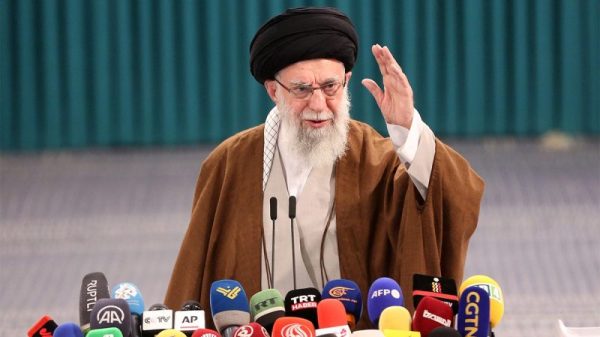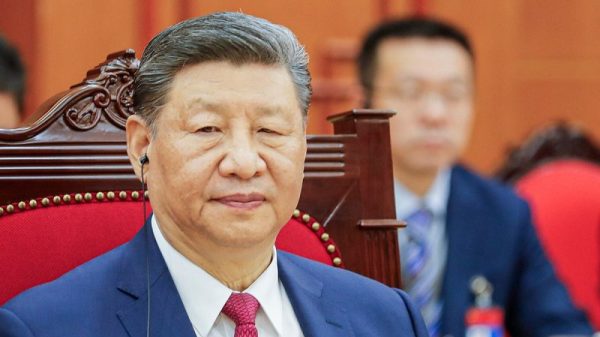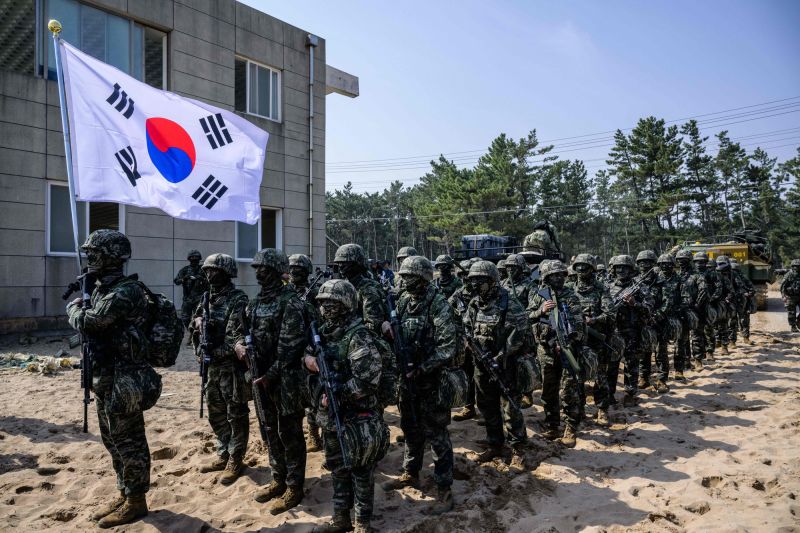South Korea, with the world’s lowest birth rate, may soon find itself without enough troops to keep its military fully staffed as it deals with new threats in an increasingly tense Western Pacific region, analysts say.
Always wary of North Korea’s nuclear and missile threats, South Korea keeps an active-duty force of about half a million troops. But with a birth rate of only 0.78 children per woman over a lifetime, the math might be South Korea’s biggest enemy at the moment, and experts say it has no choice but to downsize its forces.
“With our current birth rate, the future is predetermined. Downsizing of the force will be inevitable,” said Choi Byung-ook, a national security professor at Sangmyung University.
To maintain current troops levels, the South Korean military needs to enlist or conscript 200,000 soldiers a year, he said.
But in 2022, fewer than 250,000 babies were born. Assuming about a 50-50 male-female split, that means in 20 years, when those children are of the age to join the military, only about 125,000 men will be available for the 200,000 spots needed.
Women are not conscripted in South Korea, and volunteer females accounted for only 3.6% of the current Korean military, according to Defense Ministry figures.
And the annual number of newborns is only forecasted to drop further, to 220,000 in 2025 and 160,000 in 2072, according to Statistics Korea.
Preparing for two decades
While South Korea’s declining birth rate has been making headlines in recent years, it’s a trend the military had seen coming and prepared for.
In the early 2000s, Seoul voluntarily decided to reduce the number of active soldiers from 674,000 in 2006 to 500,000 by 2020, based on “the premise that the threat from North Korea would gradually diminish,” and to promote a smaller but more elite military force, according to a
2022 defense white paper.
South Korea’s military has reached that goal, decreasing troop size by 27.6% in two decades, from 2002 to 2022.
But the premise that the threat from North Korea would diminish has proven false.
Kim Jong Un, the third consecutive member of his family dynasty to rule, came to power in Pyongyang in 2011. Despite brief lulls while he negotiated with South Korea and the United States to reduce tensions, he has pushed a massive buildup in the North Korean military, especially in its ballistic missile programs.
Following North Korea’s test of its fifth intercontinental ballistic missile this year, Kim warned that his country would not “hesitate” to conduct a nuclear attack when the enemy provokes with its nuclear weapons, referring to the deployment of US nuclear-capable weapons platforms in
and around the Korean Peninsula, state-media KCNA reported earlier this month.
But if Kim were to attack across the 38th parallel, which divided North and South Korea after the 1953 armistice halting the Korean War, it’s the South Korean military that would bear the biggest defense burden.
Turning to tech
Experts say South Korea must look at science to counter that North Korean threat and turn a manpower crisis into a technology transformation.
“Korean defense authorities have had this longstanding policy that we would go from a manpower-centric military to a technology-oriented military,” said Chun In-bum, a former lieutenant general in the South Korean Army.
In 2005, South Korea’s Defense Ministry released a plan to develop its military into a science-technology-centric force by 2020, but progress has been scant.
“Although the military was trying to make the transition, there was no urge, because (with) South Korea’s conscripts … there were plenty of human resources,” Choi said.
But Russia’s war in Ukraine has shown the world that on the modern battlefield, sheer troop numbers aren’t enough. Of the 360,000 soldiers that made up Russia’s pre-invasion ground force, including contract and conscript personnel, Moscow has lost 315,000 on the battlefield, according to a recent US Defense Department assessment.
Ukraine’s use of drones and high-tech weapons supplied by Western partners have taken a deadly toll on Moscow’s greater force numbers.
South Korea has been putting an emphasis on integrating new technologies into its fighting units.
The Defense Ministry last year said it would make a phased transition to an AI-based manned-unmanned teaming (MUM-T) combat system, and introduced the Army TIGER brigade — a so-called “future unit” — which utilizes both manpower and unmanned equipment to carry out missions.
South Korea has also been developing unmanned military equipment, including the medium-altitude unmanned aerial vehicle (MUAV) and unmanned underwater vehicle (UUV).
Experts say troops are indispensable
But Chun, the former South Korean general, says technology is not a panacea.
For instance, it takes manpower to take and hold territory. And it takes well-trained and educated people to run and oversee artificial intelligence (AI) systems on the battlefield.
“It’s not going to be enough, and no matter how we try,” Chun said of technology. “It’s going to help, but it will not solve the problem that we lack people.”
Both he and Choi have ideas on how to get more out of a smaller military force.
For one, leverage of the conscription system and the reserve component that it yields, Chun said.
“We need to revamp our mobilization system, where we’ll be able to tap into the large number of reserve population that we have,” Chun said.
After South Korean men finish their 18 to 21 months of mandatory military service, they become reservists for eight years. During this time, they get called into assigned units once a year to remind them of their positions and duties. And after that, they are subject to participate in civil defense training every year until the age of 40.
The system now gives South Korea 3.1 million reserve troops.
Reservists must attend a two-night, three-day training session every year.
One ongoing pilot system is to have a select number of those reservists train for 180 days a year, to reinforce their skills.
Another option is increasing the number of professional cadres – commissioned, warrant and non-commissioned officers – all of whom are volunteers, serving longer terms, during which they would become well-versed in operating advanced weapons “to prevent a gap in combat capability despite the reduction of standing forces,” according to the 2022 white paper.
The military has been increasing the ratio of cadres among its total force from 31.6% in 2017 to 40.2% in 2022, according to the Defense Ministry. A further rise to 40.5% by 2027 is planned, it said.
A recruitment problem
One problem with this plan: The population isn’t buying in.
The number of applicants for commissioned officer positions has fallen over the years, from about 30,000 in 2018 to 19,000 in 2022, according to Defense Ministry data.
“The military is having a huge difficulty in securing outstanding entry-level professional cadres who would, in 10, 20 years, form an outstanding officer corps,” Choi said, pointing out that insufficient financial and social benefits for cadres are the main reason behind falling application rates.
And what about turning to women, even in a military with conscription?
Israel has conscription and 40% of its conscripted force is female, according to the Jewish Women’s Archive. In the all-volunteer US and Canadian armed forces, more than 16% of the troops are women.
Choi said conscripting women could solve South Korea’s problem, but he said there are too many impediments to it in Korea’s traditionally patriarchal society. And even if those are overcome, it could simply be too expensive.
“There are various complex factors like social costs and women giving birth. So, I think the cost [in need] would be much higher than the actual profit,” he said.
But Chun thinks attracting women volunteers is doable if the pay is attractive enough.
“If a solder is paid $2,000 [per month], that’s a legitimate job. So, a woman would say, well I want to be able to have that job for $2,000. Because for the same job, she’d probably be paid $1,500 in the outside world,” he said.
For its part, the Defense Ministry says increasing the number of women who serve is a possibility among other ideas.
But there are no timelines for changes and time may be something South Korea doesn’t have much of.
Earlier this month, Statistics Korea reported that the record low birth rate is expected to drop even further in the next two years, to 0.65 births per woman in 2025.





























